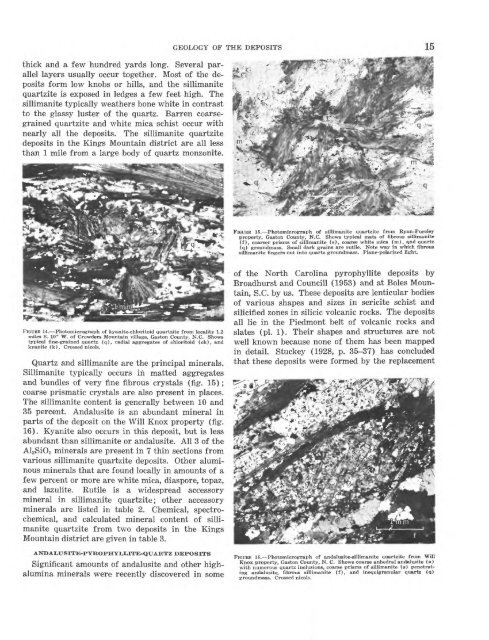Kyanite, Sillimanite, and Andalusite Deposits of the Southeastern ...
Kyanite, Sillimanite, and Andalusite Deposits of the Southeastern ...
Kyanite, Sillimanite, and Andalusite Deposits of the Southeastern ...
Create successful ePaper yourself
Turn your PDF publications into a flip-book with our unique Google optimized e-Paper software.
thick <strong>and</strong> a few hundred yards long. Several parallel<br />
layers usually occur toge<strong>the</strong>r. Most <strong>of</strong> <strong>the</strong> deposits<br />
form low knobs or hills, <strong>and</strong> <strong>the</strong> sillimanite<br />
quartzite is exposed in ledges a few feet high. The<br />
sillimanite typically wea<strong>the</strong>rs bone white in contrast<br />
to <strong>the</strong> glassy luster <strong>of</strong> <strong>the</strong> quartz. Barren coarsegrained<br />
quartzite <strong>and</strong> white mica schist occur with<br />
nearly all <strong>the</strong> deposits. The sillimanite quartzite<br />
deposits in <strong>the</strong> Kings Mountain district are all less<br />
than 1 mile from a large body <strong>of</strong> quartz monzonite.<br />
GEOLOGY OF THE DEPOSITS 15<br />
«. FIGURE 15. Photomicrograph <strong>of</strong> sillimanite quartzite from Ryan-Purcley<br />
property, Gaston County, N.C. Shows typical mats <strong>of</strong> fibrous sillimanite<br />
(f), coarser prisms <strong>of</strong> sillimanite (s), coarse white mica (m), a.nd quartz<br />
(q) groundmass. Small dark grains are rutile. Note way in which fibrous<br />
sillimanite fingers out into quartz groundmass. Plane-polarized light.<br />
FIGURE 14. Photomicrograph <strong>of</strong> kyanite-chloritoid quartzite from locality 1.2<br />
miles S. 10° W. <strong>of</strong> Crowders Mountain village, Gaston County, N.C. Shows<br />
typical fine-grained quartz (q), radial aggregates <strong>of</strong> chloritoid (ch), <strong>and</strong><br />
kyanite (k). Crossed nicols.<br />
Quartz <strong>and</strong> sillimanite are <strong>the</strong> principal minerals.<br />
<strong>Sillimanite</strong> typically occurs in matted aggregates<br />
<strong>and</strong> bundles <strong>of</strong> very fine fibrous crystals (fig. 15);<br />
coarse prismatic crystals are also present in places.<br />
The sillimanite content is generally between 10 <strong>and</strong><br />
35 percent. <strong>Andalusite</strong> is an abundant mineral in<br />
parts <strong>of</strong> <strong>the</strong> deposit on <strong>the</strong> Will Knox property (fig.<br />
16). <strong>Kyanite</strong> also occurs in this deposit, but is less<br />
abundant than sillimanite or <strong>and</strong>alusite. All 3 <strong>of</strong> <strong>the</strong><br />
Al2Si05 minerals are present in 7 thin sections from<br />
various sillimanite quartzite deposits. O<strong>the</strong>r aluminous<br />
minerals that are found locally in amounts <strong>of</strong> a<br />
few percent or more are white mica, diaspore, topaz,<br />
<strong>and</strong> lazulite. Rutile is a widespread accessory<br />
mineral in sillimanite quartzite; o<strong>the</strong>r accessory<br />
minerals are listed in table 2. Chemical, spectrochemical,<br />
<strong>and</strong> calculated mineral content <strong>of</strong> sillimanite<br />
quartzite from two deposits in <strong>the</strong> Kings<br />
Mountain district are given in table 3.<br />
ANUALTJSITE-PYROPHYLLITE-QTJARTZ DEPOSITS<br />
Significant amounts <strong>of</strong> <strong>and</strong>alusite <strong>and</strong> o<strong>the</strong>r highalumina<br />
minerals were recently discovered in some<br />
<strong>of</strong> <strong>the</strong> North Carolina pyrophyllite deposits by<br />
Broadhurst <strong>and</strong> Councill (1953) <strong>and</strong> at Boles Mountain,<br />
S.C. by us. These deposits are lenticular bodies<br />
<strong>of</strong> various shapes <strong>and</strong> sizes in sericite schist <strong>and</strong><br />
silicified zones in silicic volcanic rocks. The deposits<br />
all lie in <strong>the</strong> Piedmont belt <strong>of</strong> volcanic rocks <strong>and</strong><br />
slates (pi. 1). Their shapes <strong>and</strong> structures are not<br />
well known because none <strong>of</strong> <strong>the</strong>m has been mapped<br />
in detail. Stuckey (1928, p. 35-37) has concluded<br />
that <strong>the</strong>se deposits were formed by <strong>the</strong> replacement<br />
FIGURE 16. Photomicrograph <strong>of</strong> <strong>and</strong>alusite-sillimanite quartzite from Will<br />
Knox property, Gaston County, N. C. Shows coarse anhedral <strong>and</strong>alusite (a)<br />
with numerous quartz inclusions, coarse prisms <strong>of</strong> sillimanite (s) penetrating<br />
<strong>and</strong>alusite, fibrous sillimanite (f), <strong>and</strong> inequigranular quartz (q)<br />
groundmass. Crossed nicols.
















